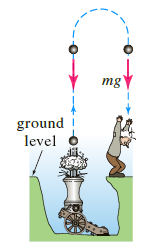(a) It is well known that the model in which air resistance is ignored, part (a)of Problem...
Question:
(b) Then, using the model in Problem 37 that takes air resistance into account, compare the value of ta with td and thevalue of the magnitude of vi with v0. A root-finding application of a CAS (or graphic calculator) may be useful here.
Data from problem 36
Suppose a small cannonball weighing 16 pounds is shot vertically upward, as shown in the following figure, with an initial velocity v0 = 300 ft/s. The answer to the question €œHow high does the cannonball go?€ depends on whether we take air resistance into account.
Suppose air resistance is ignored. If the positive direction is upward, then a model for the state of the cannonball is given by d2s/dt2 = -g (equation (12) of Section 1.3). Since ds/dt = v(t) the last differential equation is the same as dv/dt = -g, where we take g = 32 ft/s2. Find the velocity v(t) of the cannonball at time t.

Step by Step Answer:

A First Course in Differential Equations with Modeling Applications
ISBN: 978-1305965720
11th edition
Authors: Dennis G. Zill





